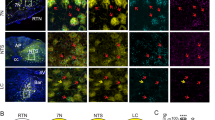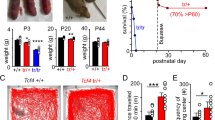Abstract
PHOX2B is a homeodomain-containing protein that is involved in the development of the peripheral nervous system and is the major disease gene for the rare congenital breathing disorder congenital central hypoventilation syndrome (CCHS). Germline PHOX2B alterations were also recently discovered in neuroblastoma cases with CCHS and/or Hirschsprung disease, but a comprehensive survey for mutational frequency and functional consequence has not been performed. We therefore studied a large panel of hereditary neuroblastomas to understand the frequency and functional effects of PHOX2B mutations. Three of 47 individuals with presumed genetic predisposition to neuroblastoma showed a germline PHOX2B mutation (6.4%). Mutations were also discovered in 2 of 30 human neuroblastoma-derived cell lines, but none of 86 primary tumors from patients with sporadically occurring neuroblastoma. The vast majority of primary tumors showed abundant PHOX2B mRNA expression relative to the remainder of the transcriptome. Consistent with its role as an important neurodevelopmental gene, forced overexpression of wild-type PHOX2B in neuroblastoma cell lines suppressed cell proliferation and synergized with all-trans retinoic acid to promote differentiation. Patient-derived mutant PHOX2B constructs retained the ability to suppress cellular proliferation, but were not able to promote differentiation or activate expression of a known PHOX2B target gene in vitro. These findings show that PHOX2B alterations are a rare cause of hereditary neuroblastoma, but disruption of this neurodevelopmental pathway can interfere with transcription-dependent terminal differentiation. These data also suggest that the genetics of neuroblastoma initiation are complex, and highlight genes involved in normal noradrenergic development as candidate predisposition genes.
This is a preview of subscription content, access via your institution
Access options
Subscribe to this journal
Receive 50 print issues and online access
$259.00 per year
only $5.18 per issue
Buy this article
- Purchase on Springer Link
- Instant access to full article PDF
Prices may be subject to local taxes which are calculated during checkout




Similar content being viewed by others
References
Amiel J, Laudier B, Attie-Bitach T, Trang H, de Pontual L, Gener B et al. (2003). Polyalanine expansion and frameshift mutations of the paired-like homeobox gene PHOX2B in congenital central hypoventilation syndrome. Nat Genet 33: 459–461.
Atienza JM, Yu N, Wang X, Xu X, Abassi Y . (2006). Label-free and real-time cell-based kinase assay for screening selective and potent receptor tyrosine kinase inhibitors using microelectronic sensor array. J Biomol Screen 11: 634–643.
Attiyeh EF, London WB, Mosse YP, Wang Q, Winter C, Khazi D et al. (2005). Chromosome 1p and 11q deletions and outcome in neuroblastoma. N Engl J Med 353: 2243–2253.
Beiske K, Ambros PF, Burchill SA, Cheung IY, Swerts K . (2005). Detecting minimal residual disease in neuroblastoma patients—the present state of the art. Cancer Lett 228: 229–240.
Dingwall C . (1991). Transport across the nuclear envelope: enigmas and explanations. Bioessays 13: 213–218.
Dubreuil V, Hirsch MR, Pattyn A, Brunet JF, Goridis C . (2000). The Phox2b transcription factor coordinately regulates neuronal cell cycle exit and identity. Development 127: 5191–5201.
Gaetano C, Matsumoto K, Thiele CJ . (1991). Retinoic acid negatively regulates p34cdc2 expression during human neuroblastoma differentiation. Cell Growth Differ 2: 487–493.
Maris JM, Weiss MJ, Mosse Y, Hii G, Guo C, White PS et al. (2002). Evidence for a hereditary neuroblastoma predisposition locus at chromosome 16p12-13. Cancer Res 62: 6651–6658.
Matera I, Bachetti T, Puppo F, Di Duca M, Morandi F, Casiraghi GM et al. (2004). PHOX2B mutations and polyalanine expansions correlate with the severity of the respiratory phenotype and associated symptoms in both congenital and late onset central hypoventilation syndrome. J Med Genet 41: 373–380.
McConville C, Reid S, Baskcomb L, Douglas J, Rahman N . (2006). PHOX2B analysis in non-syndromic neuroblastoma cases shows novel mutations and genotype–phenotype associations. Am J Med Genet A 140: 1297–1301.
Mosse YP, Laudenslager M, Khazi D, Carlisle AJ, Winter CL, Rappaport E et al. (2004). Germline PHOX2B mutation in hereditary neuroblastoma. Am J Hum Genet 75: 727–730.
Pattyn A, Morin X, Cremer H, Goridis C, Brunet JF . (1999). The homeobox gene Phox2b is essential for the development of autonomic neural crest derivatives. Nature 399: 366–370.
Trochet D, Bourdeaut F, Janoueix-Lerosey I, Deville A, De Pontual L, Schleiermacher G et al. (2004). Germline mutations of the paired-like homeobox 2B (PHOX2B) gene in neuroblastoma. Am J Hum Genet 74: 761–764.
van Limpt V, Schramm A, van Lakeman A, Sluis P, Chan A, van Noesel M et al. (2004). The Phox2B homeobox gene is mutated in sporadic neuroblastomas. Oncogene 23: 9280–9288.
Wang Q, Diskin S, Rappaport E, Attiyeh E, Mosse Y, Shue D et al. (2006). Integrative genomics identifies distinct molecular classes of neuroblastoma and shows that multiple genes are targeted by regional alterations in DNA copy number. Cancer Res 66: 6050–6062.
Weese-Mayer DE, Berry-Kravis EM, Zhou L, Maher BS, Silvestri JM, Curran ME et al. (2003). Idiopathic congenital central hypoventilation syndrome: analysis of genes pertinent to early autonomic nervous system embryologic development and identification of mutations in PHOX2b. Am J Med Genet 123A: 267–278.
Yang C, Kim HS, Seo H, Kim CH, Brunet JF, Kim KS . (1998). Paired-like homeodomain proteins, Phox2a and Phox2b, are responsible for noradrenergic cell-specific transcription of the dopamine beta-hydroxylase gene. J Neurochem 71: 1813–1826.
Yokoyama M, Nishi Y, Yoshii J, Okubo K, Matsubara K . (1996). Identification and cloning of neuroblastoma-specific and nerve tissue-specific genes through compiled expression profiles. DNA Res 3: 311–320.
Acknowledgements
This work was supported in part by NIH Grants R01-CA78545 (JMM), R01-CA87847 (JMM), U10-CA98543 (Children's Oncology Group), the Alex's Lemonade Stand Foundation (JMM), an American Society of Clinical Oncology Career Development Award (YPM) and the Abramson Family Cancer Research Institute (JMM).
Author information
Authors and Affiliations
Corresponding author
Additional information
Supplementary Information accompanies the paper on the Oncogene website (http://www.nature.com/onc).
Supplementary information
Rights and permissions
About this article
Cite this article
Raabe, E., Laudenslager, M., Winter, C. et al. Prevalence and functional consequence of PHOX2B mutations in neuroblastoma. Oncogene 27, 469–476 (2008). https://doi.org/10.1038/sj.onc.1210659
Received:
Revised:
Accepted:
Published:
Issue Date:
DOI: https://doi.org/10.1038/sj.onc.1210659
Keywords
This article is cited by
-
Genomic and transcriptomic characterization of pre-operative chemotherapy response in patients with osteosarcoma
Scientific Reports (2023)
-
Transitional care and clinical management of adolescents, young adults, and suspected new adult patients with congenital central hypoventilation syndrome
Clinical Autonomic Research (2023)
-
Targeting of intracellular oncoproteins with peptide-centric CARs
Nature (2023)
-
Recent advances in the developmental origin of neuroblastoma: an overview
Journal of Experimental & Clinical Cancer Research (2022)
-
The sympathies of the body: functional organization and neuronal differentiation in the peripheral sympathetic nervous system
Cell and Tissue Research (2021)



